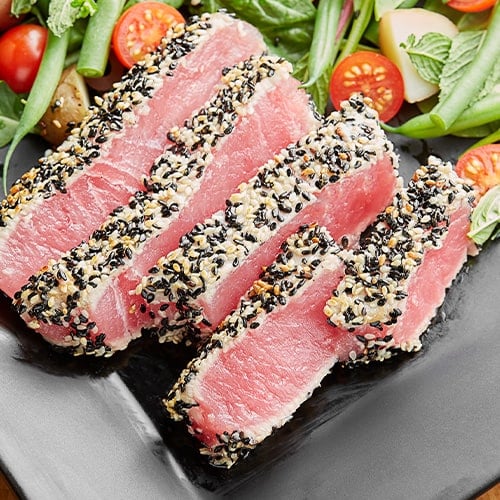Top 10 Popular Seafood Dishes
Last updated on Jan 14, 2026Janine JonesSeafood dishes are a staple in commercial kitchens around the world, offering a diverse array of flavors and textures that cater to a wide range of palates. From succulent shrimp scampi to a whole branzino bursting with flavor, seafood dishes are a popular choice for restaurants seeking to provide a diverse menu of protein offerings. Whether grilled, baked, or fried, perfectly cooked seafood dishes provide a versatile canvas for chefs to showcase their culinary skills and creativity. We created a list of the top 10 most popular seafood dishes that are sure to delight diners and elevate your menu offerings.
Shop All Seafood1. Seafood Boil

Popular in Creole cuisine, seafood boils have become a popular choice for restaurants and caterers looking to offer an interactive and communal dining experience centered around delicious seafood. This classic dish involves boiling a variety of seafood, vegetables, and seasonings in a flavorful broth. Seafood boils typically include a mix of shellfish such as shrimp, crab legs, and clams, along with corn on the cob, potatoes, and sausage. The broth used in a seafood boil is often seasoned with a blend of spices like Old Bay® seasoning, Cajun seasoning, garlic, and lemon.
Despite its impressive presentation, seafood boils are relatively easy to prepare, making them a convenient option for busy commercial kitchens. Simply boil the ingredients together in a large pot or a specialized seafood boil cooker for a delicious one-pot meal. Seafood boils are ideal for serving large groups of customers, as they can be prepared in large batches and served family-style. Seafood boils are particularly popular during the warmer months when fresh seafood is abundant. They are often featured at outdoor events such as seafood festivals, beach parties, and backyard barbecues.
- Seafood Boil Ingredients: Crab legs, clams, shrimp, sausage, corn cobs, potatoes, Old Bay® seasoning, Cajun seasoning, garlic, lemon
- Seafood Boil Complementing Flavors: Garlic butter, pineapple, orange, parsley, cilantro, margaritas, light beers
- Additional Seafood Boil Recipes: Lowcountry seafood boils, Chesapeake crab boils, New England seafood boils
2. Shrimp Scampi

Shrimp scampi, an Italian-American creation, is a classic seafood dish that is beloved by many for its delicious flavors and simplicity. This dish features succulent shrimp cooked in a garlic-infused butter sauce, often accompanied by white wine, lemon juice, and fresh herbs. Any type of shrimp can be used, but jumbo shrimp is typically preferred. Shrimp scampi's relatively low cost of ingredients and high perceived value make it a profitable menu item for commercial kitchens looking to offer a high-quality seafood option to their customers.
Shrimp scampi is known for its quick preparation time, making it an ideal choice for busy commercial kitchens looking to serve delicious seafood dishes in a timely manner. It can be served as an appetizer, main course, or even used as a topping for pasta or rice dishes. Chefs can easily customize shrimp scampi by adding their own twist with ingredients such as fresh herbs, diced tomatoes, or a touch of spice to create a signature dish.
- Shrimp Scampi Ingredients: Shrimp, butter, garlic, lemon juice, white wine, parsley
- Shrimp Scampi Complementing Flavors: Steamed vegetables, rice, pasta, crusty bread, chardonnay, clean lagers, spicy saisons
- Additional Shrimp Scampi Recipes: Shrimp scampi orzo, Shrimp scampi salad, Shrimp scampi risotto, Shrimp scampi mac and cheese
3. Fish and Chips

Fish and chips is an iconic British meal that consists of deep-fried battered fish served with crispy fries, typically accompanied by tartar sauce or malt vinegar. It is said to have originated in England in the 19th century, where it became popular among the working class as a tasty and affordable meal. The main components of fish and chips are fresh white fish fillets, typically cod or haddock, and potatoes for french fries, which are called "chips" in the UK. The fish is coated in a seasoned batter before being deep-fried to golden perfection. The dish is typically presented in a paper cone or a box, making it a popular choice for takeout or casual dining.
Fish and chips is a staple on many restaurant menus, especially in seafood establishments, pubs, and casual dining restaurants. It has transcended its British origins and is now enjoyed in countries around the world. Fish and chips pairs well with a variety of beverages, including beer, cider, and soft drinks. The crispy texture of the fish complements the effervescence of beer or the sweetness of cider. While fish and chips is available year-round in many restaurants, some establishments may offer seasonal variations using local or seasonal fish for a fresh and sustainable twist on this classic dish.
- Fish and Chips Ingredients: White fish, flour, leavening liquid, frying oil, potatoes
- Fish and Chips Complementing Flavors: Tartar sauce, malt vinegar, pilsners, pale ales, ciders
- Additional Fish and Chips Recipes: Halibut fish and chips, pollock fish and chips, Skate fish and chips, baked fish and chips
4. Branzino

Branzino, also known as European sea bass, is a popular seafood dish that is loved for its delicate flavor and tender texture. Native to the Mediterranean, branzino has a mild, sweet flavor that is often compared to red snapper or striped bass. The fish is often served whole or with the fish deboned and filleted tableside for an impressive presentation. Branzino can be prepared in a variety of ways, including grilling, baking, or pan-searing. Its firm flesh holds up well to different cooking methods, allowing chefs to experiment with different techniques to bring out the best flavors in the fish.
Branzino pairs well with a variety of flavors, including citrus, herbs, garlic, and olive oil. It can be served with roasted vegetables, risotto, or a light salad to create a well-rounded and satisfying meal for diners. Whether grilled with Mediterranean spices, baked with herbs and citrus, or pan-seared with a buttery sauce, there’s nothing quite like a whole branzino to create a truly memorable and Instagram-worthy dining experience.
- Branzino Ingredients: Whole European sea bass, fresh herbs, lemon, olive oil
- Branzino Complementing Flavors: Dill, garlic, tomatoes, olives, fennel, red onions, white wine, dry rose
- Additional Branzino Recipes: Poached branzino, baked in salt crust branzino, stuffed branzino
5. Ahi Tuna

Ahi tuna, also known as yellowfin tuna, is a premium-grade fish that is highly sought after for its firm texture and deep red color. Ahi tuna can be prepared in a variety of ways, from raw in sushi and sashimi to seared, grilled, or even baked. Some popular ways to enjoy ahi tuna include ahi poke bowls, seared ahi tuna steaks, ahi tuna tacos, and ahi tuna salads. Its mild flavor profile pairs well with a variety of ingredients, including citrus fruits, soy sauce, ginger, avocado, sesame seeds, and a wide range of sauces.
Ahi tuna is a great source of lean protein, making it a popular choice for health-conscious consumers. To fully appreciate the delicate flavor of ahi tuna, it is important to use fresh, high-quality fish. Look for tuna that is firm to the touch, with a bright red color and a fresh, ocean-like smell. Its versatility makes it a favorite ingredient in both traditional and modern culinary creations. Many foodservice providers gravitate towards wild-caught tuna for its flavor complexity, but farm-raised tuna is just as popular on restaurant menus for its accessibility.
- Ahi Tuna Ingredients: Varies depending on preparation style
- Ahi Tuna Complementing Flavors: Soy sauce, lemon, orange, ginger, avocado, ponzu, wasabi, chilled rose, sake
- Additional Ahi Tuna Recipes: Seared ahi tuna steaks, ahi tuna poke, ahi tuna wraps, baked ahi tuna
6. Crab Cakes

Crab cakes are a popular choice among diners for their rich flavor, satisfying texture, and upscale appeal. They are made from a mixture of fresh lump crab meat, breadcrumbs, mayonnaise, and various seasonings, formed into patties, and then pan-fried or baked to golden perfection. This versatile dish can be served as an appetizer, main course, or even as part of a sandwich or salad. Their adaptability makes them a popular choice on many restaurant menus. For shellfish allergies, easily swap out the crab meat for salmon.
Crab cakes pair well with sauces and accompaniments, such as tartar sauce, remoulade, aioli, or a squeeze of lemon. They can be served alongside a fresh green salad, coleslaw, or crispy fries for a satisfying meal. Crab cakes can be a profitable menu item for commercial kitchens due to their popularity and relatively high perceived value. By sourcing quality ingredients, controlling portion sizes, and pricing strategically, restaurants can maximize their profit margins while satisfying customers' cravings for this beloved seafood dish.
- Crab Cakes Ingredients: Crab meat, breadcrumbs, mayonnaise, Dijon mustard,Old Bay® seasonings, fresh herbs, lemon juice
- Crab Cakes Complementing Flavors: Coleslaw, aioli, tartar sauce, yum yum sauce, potatoes, chardonnay, pale ales, lemonade
- Additional Crab Cakes Recipes: Maryland-style crab cakes, panko crab cakes, Louisiana's spicy crab cakes, Carolina crab cakes, salmon cakes
7. Pan Seared Salmon

Pan seared salmon is a seafood dish that involves searing a salmon fillet in a hot pan to achieve a crispy exterior while keeping the inside moist and tender. Salmon is a nutrient-dense fish that is rich in heart-healthy omega-3 fatty acids, making it a popular choice with health-conscious diners. Its mild flavor and firm texture make it a versatile ingredient that can be paired with a variety of seasonings and sauces.
To achieve the perfect sear, place the salmon skin-side down in the hot pan and cook for a few minutes until the skin is crispy. Flip the salmon over and continue cooking until it reaches your desired level of doneness. The result is a beautifully seared piece of salmon with a flavorful crust and flaky flesh. Pan seared salmon can be served with a variety of side dishes such as roasted vegetables, rice, or a fresh salad. Whether served as a main course in a restaurant or as a part of a catering menu, pan seared salmon is sure to be a crowd-pleaser.
- Pan Seared Salmon Ingredients: Fresh salmon fillets, olive oil, salt, pepper, dill, parsley
- Pan Seared Salmon Complementing Flavors: Lemon, dill, garlic butter, mango salsa, asparagus, quinoa
- Additional Pan Seared Salmon Recipes: Seared salmon salad, seared salmon rice bowl, seared salmon egg scramble, creamy salmon chowder, seared salmon tacos
8. Fried Calamari

Known for its crispy texture and savory flavor, fried calamari is a sophisticated menu item that can be served as an appetizer, a main course, or even as a bar snack. Fried calamari is typically made by coating fresh squid rings in a seasoned batter or breading mixture before frying them until golden brown. The squid rings have a mild, slightly sweet flavor that is complemented by lemon, fresh herbs, and Parmesan cheese. Offer a side of marinara sauce or aioli for dipping when serving calamari to your guests.
One of the defining characteristics of fried calamari is its crispy exterior and tender interior. The contrast between the crunchy coating and the tender squid creates a satisfying eating experience. Chefs often experiment with different batters and seasonings to create unique flavor profiles for this dish. Fried calamari pairs well with a variety of side dishes, such as a crisp salad, garlic bread, or a side of pasta, making it one of the top-selling seafood dishes in many restaurants.
- Fried Calamari Ingredients: Fresh calamari rings, all-purpose flour, cornmeal, salt, pepper, paprika
- Fried Calamari Complementing Flavors: Marinara sauce, aioli, lemon juice, spicy remoulade sauce, balsamic glaze, sparkling wines, sauvignon blanc, wheat beers
- Additional Fried Calamari Recipes: Spicy calamari, calamari tacos, calamari salad, fried calamari pasta
9. Lobster Rolls

Originating from the New England region, lobster rolls have become a staple on many restaurant menus, delighting seafood enthusiasts with their rich flavors and satisfying textures. This classic sandwich consists of cold lobster meat lightly dressed with mayonnaise, a touch of lemon juice, and chopped celery, all nestled in a buttered and toasted split-top bun. This preparation allows the sweet and delicate flavor of the lobster to shine through. Fresh, succulent lobster meat sourced from reputable suppliers ensures that each bite is brimming with flavor and texture, making for a truly memorable dining experience.
Lobster rolls are often associated with summertime dining, as this is when lobster is typically in season and at its freshest. They can be enjoyed on their own or paired with a variety of sides, including coleslaw, potato chips, french fries, or a crisp garden salad, providing a well-rounded and satisfying meal. Lobster rolls have also found a home on food truck menus, where they are served up fresh to hungry customers on the go. The convenience and portability of a lobster roll make it a popular choice for street food enthusiasts.
- Lobster Rolls Ingredients: Fresh lobster, mayonnaise, lemon juice, celery, split-top bun
- Lobster Rolls Complementing Flavors: French fries, Old Bay® seasoning, chives, corn avocado, chardonnay, ginger beer, lemonade
- Additional Lobster Rolls Recipes: Butter-sauteed warm lobster roll, mayo-free lobster rolls with vinaigrette, Asian-inspired lobster rolls with kimchi, lobster tacos, lobster mac and cheese
10. Seared Scallops

Seared scallops are a highly sought-after seafood dish that graces the menus of many fine dining establishments. These delectable morsels are prized for their delicate texture and sweet, buttery flavor. The key to perfectly seared scallops lies in the cooking technique. Make sure to pat them dry with a paper towel before cooking and avoid overcrowding the pan. They should be cooked quickly over high heat to achieve a golden-brown crust while maintaining a tender interior.
Seared scallops are incredibly versatile and can be served as an appetizer, main course, or added to pasta dishes and salads. While scallops have a naturally sweet flavor, they can be enhanced with a variety of seasonings such as salt, pepper, garlic, lemon zest, and fresh herbs. Seared scallops are often served with accompaniments like risotto, pureed vegetables, or a citrus-infused sauce to complement their rich flavor. Garnish your scallops with microgreens, edible flowers, or a drizzle of high-quality olive oil to elevate their visual appeal.
- Seared Scallops Ingredients: Fresh scallops, high-heat oil, butter, salt, pepper, garlic, herbs, lemon juice
- Seared Scallops Complementing Flavors: Balsamic glaze, dill, capers, bacon, truffle, potatoes, cream sauces, yuzu, sauvignon blanc, pinot noir, pilsner
- Additional Seared Scallops Recipes: Scallop alfredo, scallops with pea puree, scallop risotto, Cajun seared scallops, scallop grenobloise
Adding seafood to your menu doesn’t have to be a daunting experience. Our list of popular seafood dishes can help you craft your own selections, whether you’re operating a casual food truck or an elegant fine dining restaurant. From appetizers to main courses, seafood is the perfect addition to draw in customers and keep them coming back for more.



